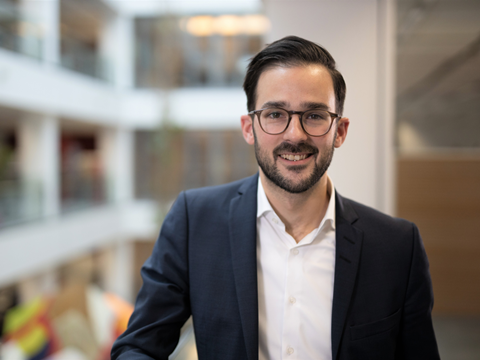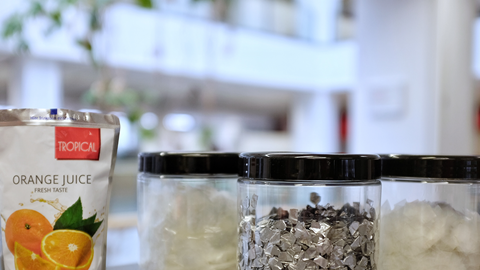One of the themes of our previous startup-focused article was the challenge young companies face when it comes to investment. This time, Victoria Hattersley looks at Saperatec, a Germany-based startup that has developed a unique technology to separate multilayer packaging films containing aluminium foil while maintaining the value of each material. Saperatec has secured investment from adhesives giant Henkel. Packaging Europe was interested to learn a little about the advantages of this relationship from both sides of the transaction – investor and investee.
It’s often younger companies, such as Saperatec, that are coming up with potentially game-changing solutions towards a circular economy. And yet many of these technologies may never reach industrialization without the necessary support. This can be from ‘angel’ investors, or from more established players who are looking to access novel technologies. For many, the latter may be the more attractive option, bringing as it does strategic benefits for both parties.
Henkel’s investment in Saperatec – announced in October 2019 – comes after two years of technical collaboration between the two companies on its separation technology.
“We are deliberately expanding into adjacent business opportunities because, as investors, we are constantly looking to get access to new technologies we cannot develop ourselves,” says Paolo Bavaj, head of corporate venturing, Henkel Adhesive Technologies.
“As a global leader in adhesives and coatings for the packaging industry, we have a very close relationship with our customers around the globe. Our understanding of their needs, combined with our industry know-how, can support startups like Saperatec to accelerate their market penetration,” adds Alexander Bockisch, global head of market strategy lamination & coating at Henkel.
And what does a major player like Henkel – as we said, already well established in its field – get from this investment in return? “In our business of Advanced Materials, it takes on average eight years to develop a new technology until commercialization,” says Paolo. “With all the competition in our globalized market, companies like Henkel are less and less willing to wait this long. With these startup relationships, we can gain rapid access to technologies with proof of concept that could be industrialized in much less time. With technologies like Saperatec’s that are not within our core capabilities, it simply doesn’t make sense to try to develop it ourselves.”
.png)
‘Unique environmental benefits’
Perhaps before we go any further, we should pause to look more closely at the Saperatec solution itself, its unique environmental benefits and why Henkel felt this was a strong strategic investment. In its simplest form, the physical-chemical process enables the separation and recycling of composite flexible packaging that contains aluminium foil. Crucially, this happens without disintegrating the materials from any of the layers (for example PE, PET and aluminium), so the materials retain their value and can be reintroduced as fresh input to the supply chain to be used for a range of industrial applications.
“The process itself is based on what we call separation fluid, which is a chemical mixture that is able to enter the boundary layers of the laminate and reduce the existing adhesive forces in order to enable a delamination,” says Dr Sebastian Kernbaum, Saperatec GmbH founder and CEO. “The underlying idea is that when you cannot treat or recycle a multilayer material as such, then separating the layers into each individual component is the best answer.”
It could be argued that the most significant benefit of this process – from both an environmental and an economic perspective – is that when the layers are separated, the outcome is materials of comparable value as at the start of the lamination process. This means, of course, less waste and also potentially one answer to that conundrum the entire industry is grappling with: the inadequate supply of high-quality recyclate.
The teaming of Henkel’s adhesives technology, which was developed and customized for this specific application, with the ability to separate laminated structures afterwards will enable the company to provide its customers with an ‘end to end’ solution: bonding and debonding. For those who feel corporates should be taking responsibility for some of the sustainable challenges they create, this is a step in the right direction.
“We are also able to reuse the liquid used for delamination; it can be circulated again following some retreatment and therefore supports sustainability within our own processes,” says Sebastian.

Alexander is also keen to point out that this solution fits neatly into the three pillars of Henkel Packaging Adhesives circular design strategy as a whole – an approach it refers to as ‘REthink Packaging’. “Investing in this process underlines our strategic focus on enabling compatibility with mechanical recycling; debonding of incompatible layers; and enabling new designs with better recyclability. For us, particularly, being able to separate aluminium-containing layers makes it possible to keep aluminium as an ideal barrier solution while offering a recyclable package at the same time. This way, of course, we are also addressing the problem of food waste: what we can offer is a solution that is both ensuring food protection and recyclability.”
Why composites?
One angle we have not yet touched upon – and some readers may also have been wondering about – is that there are plenty in the industry who argue that we should be focusing on the development of flexible monomaterials rather than looking at ways to recycle composites. But is it realistic to use monomaterials for all products, or are there some goods for which composites are essential for resource efficiency? Given the focus of this interview, I was of course interested to hear my interviewees’ take on this.
“First priority for any type of packaging will remain the protection of both consumers and the filling goods. There is a very good reason for the existence of composite structures in packaging.” says Alexander. “Take coffee, where you are typically talking about a three-layer structure: the aluminium layer will be in the middle, because you need outstanding barrier properties; on the outside you have the printable web for excellent optics in the shelf and on the inside you will have a sealable layer in order to close the packaging and maintain the highest possible pack integrity.
“So far, monomaterial solutions are predominantly used for applications with less aggressive filling goods, such as dry food, or filling goods that require less thermal treatment. At the same time, we clearly see the industry exploring new structures towards better recyclability thanks to monomaterial packaging solutions with enhanced functionality.”
And there are challenges of a more practical nature. “When it comes to monomaterials, you will have two layers of similar materials which are then printed on,” adds Paolo. “Even if you take this printed material for re-use you can only achieve a coloured PE or PP material if you do not also carry out an ink removal process, so this is another step you have to deal with. Not all problems are solved by using monomaterial solutions.”
That being said, Henkel is by no means dismissing these structures. Instead, embracing the challenges and looking to improve their performance, as Alex tells us. For example, working on oxygen barrier solutions for food applications, and Henkel has already introduced a laminating adhesive for monomaterial structures with optimized properties for mechanical recycling processes.

What next?
With the right fit, it’s clear from the above that investment in startups is of mutual benefit to both sides. But there is also the question of whether such a potentially important technology will benefit the entire market long-term: it is not solely about these two businesses, after all. The sustainability challenges Saperatec addresses are something the entire market must face.
Sebastian tells us the solution has now been industrialized and they hope to have it up and running by mid-2021 (ed. although of course it remains to be seen whether the ongoing COVID-19 pandemic will slow down such developments). So can we expect to see this technology being used on a wider scale in the coming years?
He says: “We are currently working on making it available on at least a Europe-wide but also on a global level. We really believe that this technology can become an industry standard in the long run.”

















